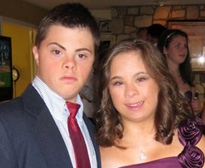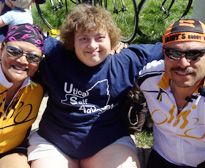
Facts

- Down syndrome is the most commonly occurring chromosomal condition. One in every approximately 700 babies is born with Down syndrome, and it is not related to race, nationality or economical levels.
- There are more than 400,000 people living with Down syndrome in the United States.
- Although the incidence of births of children with Down syndrome increases with the age of the mother, 80% of babies with Down syndrome are born to women under 35 years of age, as women in that age group give birth to more babies overall.
- People with Down syndrome have an increased risk for certain medical conditions such as congenital heart defects, respiratory and hearing problems, Alzheimer's disease, childhood leukemia, and thyroid conditions. Many of these conditions are now treatable, so most people with Down syndrome lead healthy lives.
- A few of the common physical traits of Down syndrome are low muscle tone, small stature, an upward slant to the eyes, and a single deep crease across the center of the palm. Every person with Down syndrome is a unique individual and may possess these characteristics to different degrees or not at all.
- Life expectancy for people with Down syndrome has increased dramatically in recent decades - from 25 in 1983 to 60 today.
- People with Down syndrome attend school, work, participate in decisions that affect them, often marry and contribute to society in many ways.
- All people with Down syndrome experience cognitive delays, but the effect is usually mild to moderate and is not indicative of the many strengths and talents that each individual possesses.
- Quality educational programs, a stimulating home environment, good health care, and positive support from family, friends and the community enable people with Down syndrome to develop their full potential and lead fulfilling lives.
- Individuals with Down syndrome benefit from loving homes, early intervention, inclusive education, appropriate medical care and positive public attitudes.
Proper use of language for “Down syndrome”

- Down vs. Down’s - NDSS uses the preferred spelling, Down syndrome, rather than Down’s syndrome. While Down syndrome is listed in many dictionaries with both popular spellings (with or without an apostrophe s), the preferred usage in the United States is Down syndrome. This is because an “apostrophe s” connotes ownership or possession. Down syndrome is named for the English physician John Langdon Down, who characterized the condition, but did not have it. The AP Stylebook recommends using “Down syndrome,” as well.
- People with Down syndrome should always be referred to as people first. Instead of “a Down syndrome child,” it should be “a child with Down syndrome.” Also avoid “Down’s child” and describing the condition as “Down’s,” as in, “He has Down’s.”
- Down syndrome is a condition or a syndrome, not a disease.
- People “have” Down syndrome, they do not “suffer from” it and are not “afflicted by” it.
- While it is unfortunately clinically acceptable to say “mental retardation,” you should use the more socially acceptable “intellectual disability”. NDSS strongly condemns the use of the word "retarded" in any derogatory context. Using this word is hurtful and suggests that people with disabilities are not competent.
Source: National Down Syndrome Congress
National Down Syndrome Society
Events
NEWS
NOT UP FOR THE FULL 63 MILES?
Not sure if you're up for the full ride? We have decide to try something new.




